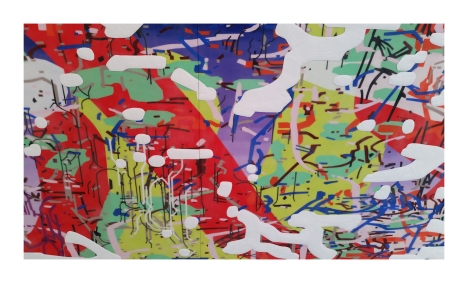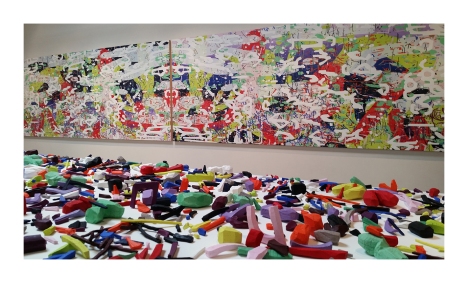Alicia McCarthy: New Paintings
Geometry has become the latest wave of abstract art to overtake the Oakland art scene. This summer, several galleries are exhibiting shows ranging from contemplative poetic geometries to sharp and mechanical op art. Of these, the new, unassuming paintings by Alicia McCarthy at Johansson Projects are outstanding. In this new, mixed-media series on found wooden panels, she transforms her temperate punk symbols into a new, formal language.
McCarthy has been painting in Oakland since the 1990s as an integrative part of the Mission School Tradition. She has had six solo shows with Jack Hanley in San Francisco, Los Angeles and New York, where she exhibited punk-painting installations. In her recent project she maintains her spontaneous aesthetic of vivid colors, while arresting them in geometric grids. However, her lines are not perfectly rigid, as they are drawn by hand, without the aid of any guidance tools or rulers.
 Even McCarthy’s black and white pieces release an iridescent glow that suggests a vivacious undertone. In the first – Untitled (1) – two stylistically different panels hang adjacent to each other. The left-hand panel displays a single word, which pops out against a dark background. The second panel displays a painted latticework, which suggests a carefully worked, woven structure. The striking presentation of a calligraphic text besides the separate image of an obviously hand-made pattern extends the work beyond the Mission School aesthetic into a wider, art-historical context, evoking the form of ancient manuscripts.
Even McCarthy’s black and white pieces release an iridescent glow that suggests a vivacious undertone. In the first – Untitled (1) – two stylistically different panels hang adjacent to each other. The left-hand panel displays a single word, which pops out against a dark background. The second panel displays a painted latticework, which suggests a carefully worked, woven structure. The striking presentation of a calligraphic text besides the separate image of an obviously hand-made pattern extends the work beyond the Mission School aesthetic into a wider, art-historical context, evoking the form of ancient manuscripts.
 In other works, McCarthy confines her patterns to partial areas of the panels. This constriction turns the patterned sections into awkward objects that stand out from the simple ground. The object in Untitled (2) is a strange, checkered pattern, corralled by a lopsided triangle at the panel’s center. In Outside/Inside, McCarthy creates a similar oddity, drawing in pencil and house paint a hive constructed from piled rectangular cells. Most of the panel, however, is left empty, resulting in a strange architecture that appears to grow from the bottom edge in a geometric mass of neatly arranged cells against a rich, greenish background.
In other works, McCarthy confines her patterns to partial areas of the panels. This constriction turns the patterned sections into awkward objects that stand out from the simple ground. The object in Untitled (2) is a strange, checkered pattern, corralled by a lopsided triangle at the panel’s center. In Outside/Inside, McCarthy creates a similar oddity, drawing in pencil and house paint a hive constructed from piled rectangular cells. Most of the panel, however, is left empty, resulting in a strange architecture that appears to grow from the bottom edge in a geometric mass of neatly arranged cells against a rich, greenish background.
The magic in McCarthy’s new works lies in their suspension between the scientific and the handmade. These original pieces show an artist mediating between these two poles. By using her grid as a direction rather than a constraint, her slightly meandering but confident contours become organic and genuine while maintaining the purpose of creating geometries. With her approximated straight lines, she redirects her gentle punk and gives it new frame and formal content.
Among the many abstract-geometrical interpretations now on exhibit in Oakland, McCarthy’s contemplative shapes stand out in the handcrafted and irregular layouts of their invented geometries.
(follow Michal Gavish on Twitter)
Filed under: Alicia McCarthy, Johansson Projects, Michal Gavish | Tagged: Alicia McCarthy, Johansson Projects, Michal Gavish, Oakland Art | Leave a comment »





